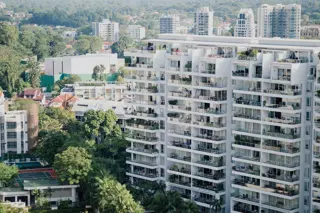Jalandhar's Architectural Transformation: A Central Hub for Luxury Living
 Punjab’s industrial heartland has become a prime location for luxury residential developments blending local adaptability with global lifestyle expectations. This shift shows Jalandhar’s changing demographics—affluent NRI investors, corporate professionals, and families valuing space, amenities, and international design standards. Leading this change is AGI Infra’s Jalandhar Heights, a flagship project redefining urban living through smart design choices.
Punjab’s industrial heartland has become a prime location for luxury residential developments blending local adaptability with global lifestyle expectations. This shift shows Jalandhar’s changing demographics—affluent NRI investors, corporate professionals, and families valuing space, amenities, and international design standards. Leading this change is AGI Infra’s Jalandhar Heights, a flagship project redefining urban living through smart design choices.
Architectural Paradigm Shift: Space and Functionality
Western lifestyle preferences in Jalandhar show in several key changes:
Open Floor Plans
- Large-configurable living areas: These spaces merge living, dining, and entertainment zones. Example: The 4 BHK flats in AGI Jalandhar Heights 2 feature 2150 sq.ft super-built areas with 3 balconies, focusing on natural light and ventilation.
- Private yet communal: Security measures like 24/7 surveillance and gated communities keep things exclusive while encouraging neighborhood interaction.
Global Amenities Integration
- Wellness-centric add-ons: In-house gyms, yoga pavilions, and jogging tracks with lots of greenery—the complex boasts 70% open space, surpassing typical urban density norms.
- De-densified living: Penthouse apartments with private swimming pools and gardens exemplify luxury preferences.
Community Living: The Rise of Recreational Hubs
Jalandhar’s luxury projects now rival international residential complexes by integrating multifunctional spaces:
| Amenity | Function |
|---|---|
| Clubhouses | Central gathering hubs with bars, multi-cuisine restaurants, and banquet halls |
| Sports Facilities | Badminton courts, basketball arenas, and squash courts within landscaped gardens |
| Health Services | On-call medical consultation and ambulance support |
| Retail Proximity | Walkable access to branded shopping malls (e.g., PVR multiplex, international fast-food chains) |
Case Study: AGI Jalandhar Heights as a Benchmark
This multi-phase development shows strategic alignment with Western urban living expectations:
- Modular Interiors: Customization options available for buyers to choose designs for kitchens, floorings, and cabinetry—a departure from traditional layouts.
- Smart Infrastructure: Earthquake-resistant structures and LPG pipelines directly connected to kitchens reflect technical modernity.
Designing for Global Standards
The architectural playbook now emphasizes:
- Large-Format Residences: 5 BHK penthouses and 2025 sq.ft villas catering to extended families and live-work arrangements.
- Energy and Water Sustainability: Harvesting systems and sewage treatment plants addressing resource-conscious living.
- Proximity to Global Ecosystems: Development near educational institutions, healthcare centers, and transit hubs appeals to expat communities.
Beyond Bricks: Cultural and Lifestyle Nuances
Projects increasingly accommodate Western social norms:
- Social Spaces Flexibility
- Community recreational areas fostering mixed-age interaction.
- Privacy-Embedded Design
- High-rise towers with private lift access and cctv-monitored spaces ensuring secure individualism.
- Experiential Retail Integration
- In-complex convenience stores and cafes reduce dependency on external markets.
Future Outlook: Evolving Priorities
As Jalandhar’s luxury market matures, developers will likely emphasize:
- Technology-Driven Living
- Smart home automation and high-speed connectivity becoming baseline expectations.
- Bespoke Customization
- Continuing trend of allowing buyers to influence finishing materials and spatial configurations.
- Eco-Conscious Design
- Non-negotiable adoption of renewable energy solutions and waste management systems.
Jalandhar’s luxury housing sector stands poised to redefine India’s urban living standards, proving how cultural adaptation and design innovation create markets previously absent in secondary cities.